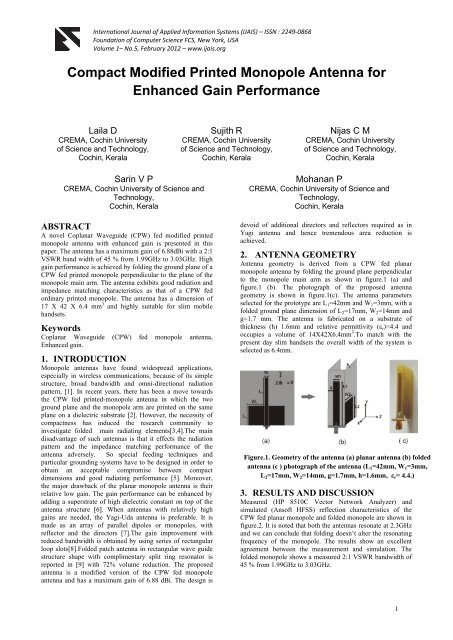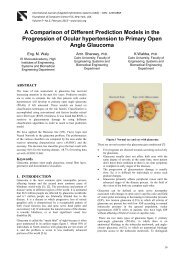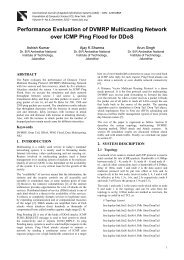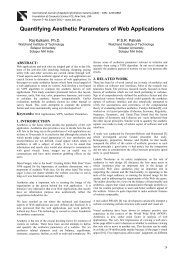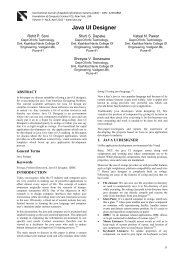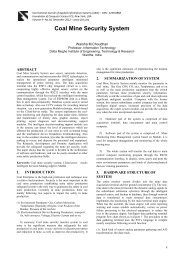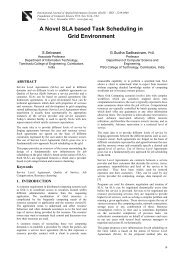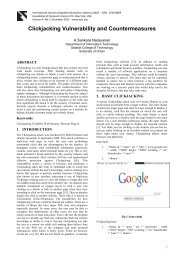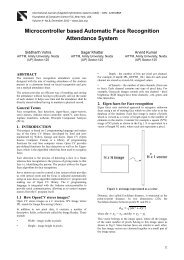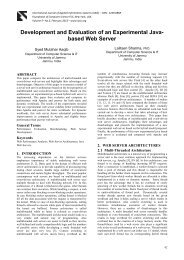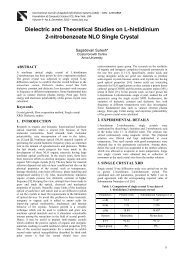Compact Modified Printed Monopole Antenna for Enhanced Gain ...
Compact Modified Printed Monopole Antenna for Enhanced Gain ...
Compact Modified Printed Monopole Antenna for Enhanced Gain ...
You also want an ePaper? Increase the reach of your titles
YUMPU automatically turns print PDFs into web optimized ePapers that Google loves.
International Journal of Applied In<strong>for</strong>mation Systems (IJAIS) – ISSN : 2249-0868<br />
Foundation of Computer Science FCS, New York, USA<br />
Volume 1– No.5, February 2012 – www.ijais.org<br />
<strong>Compact</strong> <strong>Modified</strong> <strong>Printed</strong> <strong>Monopole</strong> <strong>Antenna</strong> <strong>for</strong><br />
<strong>Enhanced</strong> <strong>Gain</strong> Per<strong>for</strong>mance<br />
Laila D<br />
CREMA, Cochin University<br />
of Science and Technology,<br />
Cochin, Kerala<br />
Sarin V P<br />
CREMA, Cochin University of Science and<br />
Technology,<br />
Cochin, Kerala<br />
ABSTRACT<br />
A novel Coplanar Waveguide (CPW) fed modified printed<br />
monopole antenna with enhanced gain is presented in this<br />
paper. The antenna has a maximum gain of 6.88dBi with a 2:1<br />
VSWR band width of 45 % from 1.99GHz to 3.03GHz. High<br />
gain per<strong>for</strong>mance is achieved by folding the ground plane of a<br />
CPW fed printed monopole perpendicular to the plane of the<br />
monopole main arm. The antenna exhibits good radiation and<br />
impedance matching characteristics as that of a CPW fed<br />
ordinary printed monopole. The antenna has a dimension of<br />
17 X 42 X 6.4 mm 3 and highly suitable <strong>for</strong> slim mobile<br />
handsets.<br />
Keywords<br />
Coplanar Waveguide (CPW) fed monopole antenna,<br />
<strong>Enhanced</strong> gain.<br />
1. INTRODUCTION<br />
<strong>Monopole</strong> antennas have found widespread applications,<br />
especially in wireless communications, because of its simple<br />
structure, broad bandwidth and omni-directional radiation<br />
pattern, [1]. In recent years, there has been a move towards<br />
the CPW fed printed-monopole antenna in which the two<br />
ground plane and the monopole arm are printed on the same<br />
plane on a dielectric substrate [2]. However, the necessity of<br />
compactness has induced the research community to<br />
investigate folded main radiating elements[3,4].The main<br />
disadvantage of such antennas is that it effects the radiation<br />
pattern and the impedance matching per<strong>for</strong>mance of the<br />
antenna adversely. So special feeding techniques and<br />
particular grounding systems have to be designed in order to<br />
obtain an acceptable compromise between compact<br />
dimensions and good radiating per<strong>for</strong>mance [5]. Moreover,<br />
the major drawback of the planar monopole antenna is their<br />
relative low gain. The gain per<strong>for</strong>mance can be enhanced by<br />
adding a superstrate of high dielectric constant on top of the<br />
antenna structure [6]. When antennas with relatively high<br />
gains are needed, the Yagi-Uda antenna is preferable. It is<br />
made as an array of parallel dipoles or monopoles, with<br />
reflector and the directors [7].The gain improvement with<br />
reduced bandwidth is obtained by using series of rectangular<br />
loop slots[8].Folded patch antenna in rectangular wave guide<br />
structure shape with complimentary split ring resonator is<br />
reported in [9] with 72% volume reduction. The proposed<br />
antenna is a modified version of the CPW fed monopole<br />
antenna and has a maximum gain of 6.88 dBi. The design is<br />
Sujith R<br />
CREMA, Cochin University<br />
of Science and Technology,<br />
Cochin, Kerala<br />
Nijas C M<br />
CREMA, Cochin University<br />
of Science and Technology,<br />
Cochin, Kerala<br />
Mohanan P<br />
CREMA, Cochin University of Science and<br />
Technology,<br />
Cochin, Kerala<br />
devoid of additional directors and reflectors required as in<br />
Yagi antenna and hence tremendous area reduction is<br />
achieved.<br />
2. ANTENNA GEOMETRY<br />
<strong>Antenna</strong> geometry is derived from a CPW fed planar<br />
monopole antenna by folding the ground plane perpendicular<br />
to the monopole main arm as shown in figure.1 (a) and<br />
figure.1 (b). The photograph of the proposed antenna<br />
geometry is shown in figure.1(c). The antenna parameters<br />
selected <strong>for</strong> the prototype are L 1=42mm and W 1=3mm, with a<br />
folded ground plane dimension of L 2=17mm, W 2=14mm and<br />
g=1.7 mm. The antenna is fabricated on a substrate of<br />
thickness (h) 1.6mm and relative permittivity (ε r)=4.4 and<br />
occupies a volume of 14X42X6.4mm 3 .To match with the<br />
present day slim handsets the overall width of the system is<br />
selected as 6.4mm.<br />
Figure.1. Geometry of the antenna (a) planar antenna (b) folded<br />
antenna (c ) photograph of the antenna (L 1=42mm, W 1=3mm,<br />
L 2=17mm, W 2=14mm, g=1.7mm, h=1.6mm, ε r= 4.4.)<br />
3. RESULTS AND DISCUSSION<br />
Measured (HP 8510C Vector Network Analyzer) and<br />
simulated (Ansoft HFSS) reflection characteristics of the<br />
CPW fed planar monopole and folded monopole are shown in<br />
figure.2. It is noted that both the antennas resonate at 2.3GHz<br />
and we can conclude that folding doesn‟t alter the resonating<br />
frequency of the monopole. The results show an excellent<br />
agreement between the measurement and simulation. The<br />
folded monopole shows a measured 2:1 VSWR bandwidth of<br />
45 % from 1.99GHz to 3.03GHz.<br />
1
International Journal of Applied In<strong>for</strong>mation Systems (IJAIS) – ISSN : 2249-0868<br />
Foundation of Computer Science FCS, New York, USA<br />
Volume 1– No.5, February 2012 – www.ijais.org<br />
Figure.2. Reflection characteristics of planar and<br />
folded monopole antenna<br />
Measured 2D radiation patterns in the XZ and YZ plane and<br />
the simulated 3D radiation pattern of the folded antenna are<br />
shown in figure.3 and figure.4. respectively. It is noted that<br />
the folded antenna exhibits a non-directional pattern along the<br />
azimuth plane and is maintaining linear polarisation as that of<br />
ordinary monopole, throughout the band.<br />
Figure.3. Measured radiation pattern of the<br />
folded antenna at resonant frequency (a) XZ<br />
plane (b) YZ plane<br />
Figure 4 Simulated 3D radiation pattern of<br />
the folded antenna<br />
Figure.5 shows the measured gain plot of the planar and<br />
folded antennas. It is interesting to note that the folded<br />
antenna has a maximum gain of 6.88dBi, which is much<br />
greater than that of the conventional planar antenna (1.9dBi).<br />
A maximum gain enhancement of 4.077dBi is achieved at<br />
2.54GHz.<br />
Figure.5 Measured gain of the antennas<br />
Figure.6 Simulated Electric field distribution at resonant<br />
frequencies of (a) planar monopole (b) folded monopole<br />
The enhancement in gain can be best understood by<br />
comparing the fringing electric field patterns of the ordinary<br />
monopole and the folded monopole as shown in figure.6 (a)<br />
and (b). It is observed that the fringing electric field between<br />
the ground planes and the monopole arm are out of phase in<br />
the case of ordinary printed monopole antenna and it cancels<br />
the field at the far field giving reduced gain. But <strong>for</strong> the folded<br />
monopole, effectively adds the fringing fields at the bore sight<br />
giving an enhanced gain.<br />
4. CONCLUSION<br />
A novel compact folded monopole antenna with enhanced<br />
gain per<strong>for</strong>mance is presented .The antenna offers maximum<br />
gain of 6.88dBi with good radiation and matching<br />
characteristics. A gain enhancement of nearly 4 dBi is<br />
observed at 2.54GHz. The antenna is highly compact and<br />
hence it can be used with modern wireless handheld devices.<br />
5. ACKNOWLEDGEMENT<br />
The Authors would like to acknowledge Institute of Human<br />
resources and Development (IHRD), Govt of Kerala and<br />
Department of Science and Technology (DST), Govt. of India<br />
<strong>for</strong> financial assistance.<br />
2
International Journal of Applied In<strong>for</strong>mation Systems (IJAIS) – ISSN : 2249-0868<br />
Foundation of Computer Science FCS, New York, USA<br />
Volume 1– No.5, February 2012 – www.ijais.org<br />
6. REFERENCES<br />
[1] P. Agrawall, G. Kumar, and K. Ray,‟Wideband Planar<br />
<strong>Monopole</strong> <strong>Antenna</strong>s‟, IEEE Trans on <strong>Antenna</strong>s and<br />
Propagation.,vol-46,No 2, pp. 294-295, February1998.<br />
[2] Tzyh-Ghuang Ma, Chao-Hsiung Tseng, ,‟An<br />
Ultrawideband Coplanar Waveguide-Fed Tapered Ring<br />
Slot <strong>Antenna</strong>., IEEE Trans on <strong>Antenna</strong>s and<br />
Propagation, Vol. 54, No. 4, April 2006<br />
[3] T. Tsukiji, Y. Kumon and M. Yamasaki,‟ Double-folded<br />
monopole antenna using parallel line or coaxial cable‟,<br />
IEE Proc.-Microw. <strong>Antenna</strong>s Propag., Vol. 149, No. 1,<br />
pp.17-22,February 2002<br />
[4] Z.N. Chen, M.Y.W. Chia and M.J. Ammann,<br />
„Optimization and Comparison of Broadband<br />
<strong>Monopole</strong>s‟, IEE Proc.- Microw. <strong>Antenna</strong>s Propag., Vol.<br />
150, No. 6, pp.429-435, December 2003.<br />
[5] S.W. Su, K.L Wong and C.L. Tang, „Ultra-wideband<br />
square planar monopole antenna <strong>for</strong> IEEE 802.16a<br />
operation in the 2-11 GHz Band‟, Microwave and<br />
Optical Technology Letter,Vol. 42, No. 6, pp.463-<br />
466,September 2004<br />
[6] H.Y. Yang and N.G. Alexopoulos, „<strong>Gain</strong> enhancement<br />
methods <strong>for</strong> printed circuit antennas through multiple<br />
Vol. 35,No.7, pp. 860-863, July 1987<br />
[7] H. K. Kan, R. B. Waterhouse, A. M. Abbosh, and M. E.<br />
Bialkowski,‟ Simple Broadband Planar CPW-Fed<br />
Quasi-Yagi <strong>Antenna</strong>‟, IEEE <strong>Antenna</strong>s and wireless<br />
popag letters, Vol. 6, pp 18-20, 2007<br />
[8] Xing Chen, Kama Huang, and Xiao-Bang Xu “A novel<br />
planar slot array antenna with omni directional pattern” ,<br />
IEEE Trans on <strong>Antenna</strong>s and Propagation, Vo. 59, No.<br />
12, December 2011 ,pp4853-4857<br />
[9] Xiaoyu Cheng*, Jun Shi, Cheolbok Kim, David Senior<br />
and Yong-Kyu Yoon “A <strong>Compact</strong> Self-packaged Patch<br />
<strong>Antenna</strong> with Non- Planar Complimentary Split Ring<br />
Resonator Loading” International symposium on<br />
antennas and propagation (APSURSI) 2011,pp 1036-<br />
1039.<br />
3


